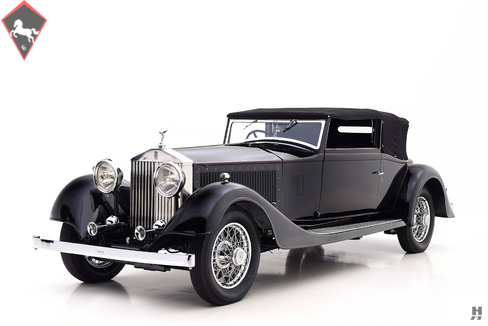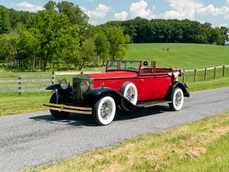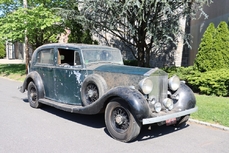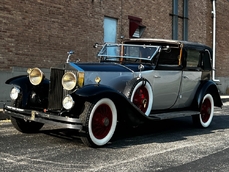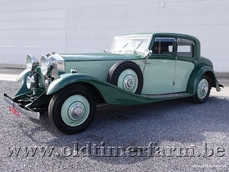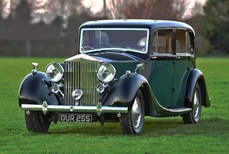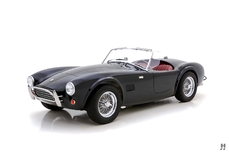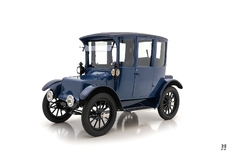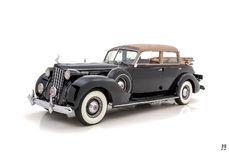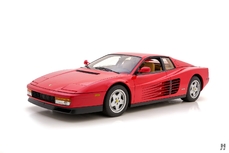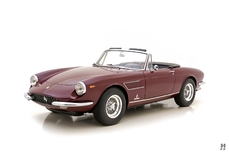Rolls-Royce Phantom II 1934
Allmän beskrivning :
Between 1929 and 1935, the magnificent Phantom II sat atop the Rolls Royce range. Serving as a replacement for the original Phantom, the Phantom II was completely redesigned from the ground up, and shared very little in common with its predecessor beyond the bore and stroke dimensions of the 7,668cc inline six-cylinder engine. Engineers made a great deal of progress within the big six; with a cross flow cylinder head, separate inlet ports, improved exhaust manifold and a bump in compression finding an additional 20hp. The driveline was also improved with modifications to the gearbox and clutch and the addition of a Hotchkiss drive layout for the hypoid rear axle which allowed for a lower floor line. This of course delighted coachbuilders who could now fit ever sportier and sleeker bodywork. Performance was exceptional for a car of this size, and sales proved strong considering the price, with 1,767 built over a seven year run. Of course, Rolls Royce was never one to rest on its laurels, so over sixty running changes were made during the course of production to further refine and enhance the Phantom II.
In the early 1920’s, the President of Brazil suggested to his wealthy friend Octavio Guinle that Rio de Janeiro needed a world class beachfront hotel. Guinle took up the challenge and hired French architect Joseph Gire to design a fabulous new building. The Copacabana Palace, as it would become known, was built to be the very best and it soon became a destination for royalty, Hollywood stars, and the social and business elite of the world. In the late 1920s, his hotel a rousing success, the time came for Guinle to order a new automobile and he looked no further than Rolls-Royce’s new flagship, the Phantom II. An aficionado of French design, Guinle turned to one of Paris’ most exclusive coachbuilders, Henri Binder, to supply the bodywork. Binder was well established as a constructor of high-quality coach bodies, and successfully transitioned to automobile bodies at the turn of the century. Binder bodies were traditionally very stylish and exceptionally well-constructed, usually gracing big, powerful chassis from Minerva, Delage, Cadillac, and even one of the six majestic Bugatti Type 41 Royales. Guinle’s Phantom II (wearing chassis number 103GY) was sold through Oscar A. Cox & Co. of London, and was delivered to Binder on July 31st of the same year. After completion of the dramatic drophead coupe body, it was shipped to Rio where it remained in Guinle’s possession until 1938. Subsequent owners included Mr. W.D. Radcliffe of Liverpool, B. Stinton Johnson of Stretton Hall, Cheshire from 1947-1950 and Neil Tuson of London. It then found its way to the United States where it was featured in several prominent collections including Bill Lassiter, The Blackhawk Collection, the Imperial Palace Collection and then finally with Dr. Donald Vestley who took the opportunity to restore this beautiful machine in 1986.
Under the guidance of Mr. Vestley, 103GY underwent a comprehensive restoration. Coincidentally, Vestley had another PII, chassis number 162SK, in his possession. 162SK was a fully restored, bare chassis and one of the very late production cars that had benefited from the refinements made by Rolls Royce. 162SK was originally delivered wearing formal Sedanca deVille coachwork by Windovers but that body had long been separated with the chassis. It was decided that the restored body and engine of 103GY would be mated to the improved long-wheelbase 162SK chassis. Now, the magnificent Binder Drophead bodywork rode on a chassis that featured more refined suspension, central lubrication and improved handling, making it an ideal choice for drivers.
Today, 162SK presents in lovely condition, painted black with a matching fabric roof, offset by a subtle red pinstripe to compliment the striking red interior. The Binder coachwork is long, sleek and sexy, with a unique dropping rear body line and a low-slung three-position Victoria-style roof. Dual rear-mount spares keep the body sides clean and help make the body look even longer and lower. A useful trunk is integrated into the rear bodywork, fitting nicely between the rear wings. The black paintwork suits the spectacular lines and presents in good condition, showing some age in places but keeping a handsome patina overall. The red leather cabin is similarly patinated but very inviting and usable. The engine compartment is tidy and very presentable, the massive “six” having been overhauled in 2000 and remaining quite strong today.
It is not uncommon for pre-war Rolls-Royce motorcars to wear several different bodies in their lifetime. What makes 162SK special is the combination of comprehensive and interesting history, the magnificent sporting coachwork and a wonderfully sorted late-specification chassis. Rarely do we find a Phantom II with such special coachwork that is also an outstanding driver; its mechanical and cosmetic condition making it a simply jaw-dropping RROC or CCCA tour car.
https://hymanltd.com/vehicles/5567
1934 Rolls-Royce Phantom II is listed såld on ClassicDigest in St. Louis by Mark Hyman for $475000.
Fakta i bilen
Karosstyp : Personbil Märke : Rolls-Royce Modell : Phantom II Motorvolym : 0.0 Årsmodell : 1934 Karosstyp : Convertible Läge : Missouri
Såld
Information om säljaren
Såld
People who viewed this Rolls-Royce Phantom II also viewed similar Rolls-Royce listed at ClassicDigest
Other cars listed for sale by this dealer
om Rolls-Royce
Nåväl, damer och herrar, idag dyker vi in i den lysande historien om ett varumärke som alltid har inneburit själva essensen av brittisk lyx och hantverk - Rolls-Royce.Vår historia börjar vid förra sekelskiftet när två visionärer, Charles Rolls och Henry Royce, beslutade att gå samman. År 1904 föddes den allra första Rolls-Royce, Rolls-Royce 10 hp. Det var en blygsam början för ett företag som skulle omdefiniera bilens överlägsenhet.
Men det var inte förrän 1907 som Rolls-Royce verkligen gjorde sin stämpel med introduktionen av Silver Ghost. Den hyllades som "Världens bästa bil" och satte gulstandard för lyxkörning. Med sin tystlåtna motor och utsökta hantverk var det en symbol för överflöd och förfining.
1920-talet förde oss Rolls-Royce Phantom I, en ikon för sin tid. Det var den första Rolls-Royce med en 6-cylindrig motor och lade grunden för den legendariska Phantom-serien. Detta var eran när Maharadjor i Indien beställde specialbyggda Rolls-Royces som var inget mindre än bilpalats.
Snabbspola till efterkrigsåren, och vi har Silver Cloud, en symbol för det brittiska efterkrigsoptimismen. Silver Cloud var elegans personifierad, med sina flytande linjer och handgjorda interiörer. Det var valet för kungligheter, kändisar och kaptenar inom industrin.
Men om vi pratar om Rolls-Royces lyx i sin fulländning, är det Rolls-Royce Phantom VI som graciöst dök upp i våra liv från 1968 till 1991. Det här var en bil som gjorde uttalandet att "om du måste fråga priset kan du inte ha råd det." Anpassning var nyckelordet, och Phantom VI var en canvas för världens rikaste för att uttrycka sina unika smaker.
Nu är det omöjligt att diskutera Rolls-Royce utan att nämna Rolls-Royce Corniche. Producerad från 1971 till 1995 var det en cabriolet- och coupéversion av Silver Shadow. Corniche var den ultimata grand tourern, en bil för dem som ville färdas över kontinenter i absolut lyx.
Men, ack, även de mäktigaste måste möta sin nedgång, och Rolls-Royce var inget undantag. Företaget genomgick ekonomiska prövningar på 1970- och 80-talen, vilket ledde till övertagandet av Vickers plc. Sedan kom den kontroversiella ägandeperioden av BMW och Volkswagen, som delade entusiasterna.
Rolls-Royce återfick fotfästet under BMW-ägande, och det nya millenniet förde oss Rolls-Royce Phantom VII, en återgång till företagets rötter av kompromisslös lyx. Phantom VII var ett vittnesmål om brittisk ingenjörskonst och hantverk.
Och det, damer och herrar, för oss till idag. Rolls-Royce fortsätter att producera några av de mest overdådiga, specialtillverkade fordon på planeten, en symbol för brittisk imperium som inte har falnat med tiden. Anden av Sir Henry Royce och Charles Rolls lever vidare i varje bil som bär Spirit of Ecstasy, ett vittnesmål om det bestående arvet av brittisk bilöverlägsenhet.
